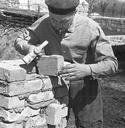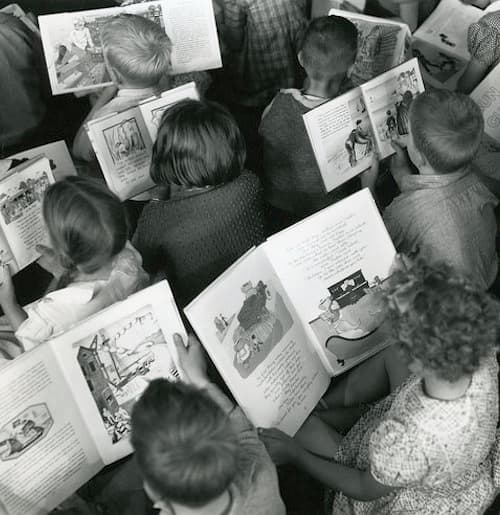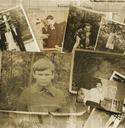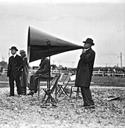Westminster Cathedral Choir School, where I’m privileged to teach, sits snugly behind the neo-Byzantine arches and domes of the Cathedral, a stone’s throw from Parliament and Westminster Abbey in one direction and Buckingham Palace in the other. Founded in 1902 to educate Roman Catholic boys (aged 8-13) as choristers for Cardinal Vaughan’s newly-erected cathedral, over the decades it has admitted increasing numbers of day-boys to the school (they don’t sing in the cathedral choir). Today, day-boys outnumber choristers by nearly five-to-one, but the choristers’ musical training makes them still the transformative element in the school’s culture.
Choristers board at the school and at 7:30 a.m. every room and corridor comes alive with boys tussling with their instruments before assembling for song school where they practice the music for that evening’s Mass. Typically this will be a range of medieval plainsong, Renaissance polyphony and work by distinguished modern composers such as James MacMillan, many of whom have been commissioned to write pieces for the choir. By the time academic lessons begin at 9:15 a.m. the choristers are hitting the ground running and the day-boys have to keep pace.
The choir school tradition is a venerable one: England’s first school was a choir school, established by St. Augustine of Canterbury soon after his arrival to evangelize the Anglo-Saxons in 597 AD. The medieval curriculum of trivium and quadrivium taught boys how to sing and understand the liturgy and enabled them to maintain the culture of western monasticism. After the Reformation the abbeys and cathedrals became “bare ruined choirs where late the sweet birds sang”[1] but at Westminster Cathedral we proudly claim to continue the tradition; all other prestigious choir schools are in the Anglican tradition.
The musical tradition has been in place since 1902 but we have only more recently sought to renew our curriculum, aided by the writings of Stratford Caldecott. The English Catholic historian, Christopher Dawson (1889-1970), whom Caldecott greatly admired, recognized that the modern conservative’s options were limited when it came to the curriculum. To simply turn back the clock meant a classical curriculum hewn solely from the rock of Greek and Roman culture. This was the standard English “public school” education (as in Eton, Harrow and Winchester—the latter Dawson’s own school) as it existed prior to the Second World War.
As with so much that seemed impervious to change, the edifice of the classical curriculum crumbled in the mid-twentieth century as advocates of child-centered learning prioritized the “how” (learning style) over the “what” (content). As John Dewey conceived it, education became a democratic process accessible to everyone; exams were frowned on, or just dumbed down so that everyone could pass them, while “elitist” subjects such as Latin and Greek became a rarity. In an age of relativism, who was to say that one book was better than another? Why Shakespeare? Why so many dead white males? I wasn’t teaching at the time, but The Corruption of the Curriculum edited by Robert Whelan is a sobering read. The academic content of every subject was undermined. Geography was no longer about maps but about sustainability and green issues; science was no longer about understanding the material order but about healthy eating; in the teaching of languages, grammar was out and learning was by immersion, as though we continue to learn foreign languages in the way we learned our mother tongue as infants.
But with the old curriculum banished to the dustbin of history, what alternative to progressive education remains? In The Crisis of Western Education (1961), Dawson wrote that:
the old humanist education, with all its limitations and faults, possessed something that modern education has lost. It possessed an intelligible form, owing to the fact that the classical culture which it studied was seen as a whole, not only in its literary manifestations but also in its social structure and its historical development. Modern education has lacked this formal unity, because it has never attempted to study modern civilization with the care and earnestness which humanist education devoted to classical culture. Consequently, the common background of humanist culture has been lost, and modern education finds its goal in competing specialisms.[2]
At our school I have begun the task of building a curriculum that has an “intelligible form” because without such a form the pupils will be lost. Inspired by the curriculum plan of St. Jerome Academy (located in Hyattsville, Maryland)[3], each year takes an epoch of civilization, beginning with the Ancient Year in Grade 2 and cycling through Medieval and Modern years twice over a pupil’s time at the school. My own poetry anthologies make literary links to what the pupils study in History, and the Art curriculum has been similarly designed to present an integrated picture of culture. While links are plentiful, the lines between subject disciplines are retained; in fact, they are emphasized.
If the content side of our new curriculum originates in Dawson, then it is complemented by Caldecott, who salvages much that is good in child-centred learning, particularly as applied to the early years of education. Caldecott’s thinking is imbued with the personalism of John Paul II and he avoids any objectification of the curriculum separated from its role in the development of the pupil. However, he also recognizes that, “In modern progressive education,” the skills of “thinking, remembering, communicating, calculating … have been neglected, leading at times to an over-reaction in conservative schools where they may be drilled into children more assiduously.”[4] So we are seeking a golden mean.
One of the great joys of our new curriculum has been our regular assemblies dedicated to poetry declamations. I remember distinctly one seven-year-old boy reciting “The Lord is my Shepherd” (from the Authorized Version), an eight-year-old duo declaiming Tennyson’s “The Charge of the Light Brigade,” and a twelve-year-old’s barnstorming rendition of Henry V’s St. Crispin’s Day oration. Every boy in the year learns the same poem and the winner performs the piece before the school and their parents. The results have been remarkable and the building of confidence that comes from well-rehearsed performance is a great gift for life.
I am sure that in the past memorization (of dates, catechism, poetry) was learned through empty formalism reinforced by brutality, but we should judge an activity by its best rendering rather than its worst. Whereas the old humanist education was arguably preoccupied with the translation of Latin and Greek into English (or even from Latin into Greek and vice versa), a modern liberal education will be more humane, with a higher regard for what Caldecott calls “the education of the imagination [which] is the education of the heart.” A modern liberal education—as sketched by Caldecott in his chapter “Dreaming a Catholic School” in Beauty in the Word—will give academic structure but also room for personal growth. I think I’ve seen some glimpses of this vision.
Not so long ago, a colleague came to see me in the staff room. I had taught English to the fourth grade before handing them over to him for History. They had stood behind their chairs—as they should—but then something unexpected happened that my colleague had assumed was a piece of mischief on my part. The class en masse began to declaim G. K. Chesterton’s great battle poem “Lepanto.” The truth was that the idea had come entirely from them and was a first fruit of our new curriculum structure. The boys were beginning to see culture as a coherent whole. In this case, Chesterton’s narrative masterpiece was being discussed, memorized and declaimed in English at the same time as they studied the Elizabethans, Philip II and the Ottoman Empire in History. Various light-bulbs were being switched on. As Chesterton wrote in Orthodoxy, “Thinking means connecting things, and stops if they cannot be connected.” Our curriculum is designed to enable the boys to make as many connections across subjects as possible and thus, aided by the more strictly logical subjects—math and Latin, particularly—to learn to think.
I would be using poetic license to the extreme if I reported spontaneous outbreaks of popular enthusiasm from every class—it wouldn’t be school then, would it?—but the boys are definitely on board with the project. This applies even to the activities that don’t plug into their imagination. With my Fourth Grade class, I spent a lot of time earlier in the year re-introducing the Palmer method of cursive script (having taught it to myself first). When I was satisfied with the improvement, I left cursive on the back burner for a few weeks, half-thinking they would be glad of a rest. “When are we going to do handwriting again, sir?” they soon asked me. Handwriting lessons are a miniature illustration of true liberal education. Progressive education—no handwriting lessons. Rigidly conservative education—everyone writes in the same way. Liberal education—learn the conventions and then develop your own style. Kitty Burns Florey’s Script & Scribble: The Rise and Fall of Handwriting is a particularly enjoyable apologia for handwriting.
Like handwriting, teaching formal grammar is associated with dry-as-dust formalism, but it ain’t necessarily so. A heavy dose of irony often helps. “Let’s get this poem out of the way quickly, boys, so that we can spend more time on grammar today.” After wry and sceptical glances the class is usually won over to the eight parts of speech, adverbial phrases and subordinate clauses. I always emphasize that they use these grammatical forms every day in the playground; we are just putting a name to a face. As with handwriting, it’s through repetition that the boys make progress, and they quite like the repetition. We do drill after drill: I don’t get any complaints, though after fifteen minutes it’s usually time for something more light-hearted. Little and often seems to work well with formal grammar. If you are serious about teaching grammar, try to get hold of a copy of Tim Ledgard’s The Grammar Book.
As a prep school teacher, I’m glad that I don’t teach punctuation and grammar all day. Whereas I teach English to the Fourth Grade, I teach History to the Sixth. Sixth Grade covers my favourite period in English history—1066-1485—and is a fairly brisk walk-through of the great kings and saints of medieval England. We have a particular devotion to the Jesuit martyr St. Edmund Campion (d. 1581), who at his trial in Westminster Hall (just down the road from us), spoke of “our own ancestors, all our ancient bishops and kings, all that was once the glory of England—the island of saints, and the most devoted child of the See of Peter.” If the Reformation attempted to sever generations of Englishmen from that heritage, it’s a satisfying thought that we might be restoring the historical and imaginative link between England and Christendom.
But no period of history is a truly golden age and we’ve looked at the fascinating figure of St. Joan of Arc, who after defeating the English in a flurry of battles was captured, imprisoned and burned to death by her English enemies and the treacherous Burgundians in Rouen in 1431. Joan was a very witty young woman who liked to tell the priests that “my Lord has a book that you have not read” and when questioned by a clerk with a strong southern accent what language St. Margaret and St. Michael spoke in the visions she received, retorted, “Better than yours!”; and, asked whether she believed in God, her response was, “More than you!” Having been burned to death by the English as a witch and a heretic, I hope she is pleased that at an all-boys Catholic school in London we cherish her memory and heroism.
In practical terms we have had to work hard to put together the resources for this part of the curriculum. In History we have the benefit of the actual trial records—of the trial that condemned her and of the rehabilitation trial a quarter of a century later—and so we have the words of her accusers, her friends and of Joan herself; the work of Régine Pernoud (Ignatius Press) is particularly useful. In English the boys have studied excerpts from Shakespeare’s Henry VI Part 1, and various passages from Mark Twain’s splendid novel, Joan of Arc (the novel is rather too long for class use so I’ve produced a booklet of fifteen excerpts with questions). In Religious Studies, where we have been studying the sacraments, it was not too much of a digression to teach a double lesson on Joan, with her remarkable piety, confessing frequently and receiving Holy Communion daily whenever she could. Pope Benedict’s 2011 papal audience on Joan is the ideal resource to adapt for classroom use.
I could go on with examples of joined-up thinking in the curriculum. But what are we striving to achieve, at a deeper level? To understand what we are aiming at I would recommend Stratford Caldecott’s book on the trivium, Beauty in the Word: Rethinking the Foundations of Education. It is a profound and impressive work, summarizing the ideas of many writers that, frankly, few teachers would otherwise encounter. Caldecott reminds us of the deeper reasons for why we teach language to children:
Language, grammar, syntax, and vocabulary exist for a purpose and that purpose is revealed only in the search for truth. As Chesterton saw, it is the search for truth that keeps us sane, because it always brings us back to reality. And why is reality so important? It is what we are made for. Reality is the food of the soul.[5]
Liberal education is a tradition rather than an ideology, and part of its beauty is that no two liberal arts schools will be identical. This is what Dawson and Caldecott sought for modern education—a curriculum that had a coherent form, that was broad in its coverage and which was truly open to the human person—teacher and pupil—in all his dimensions.
[1] William Shakespeare, Sonnet 73.
[2] Christopher Dawson, The Crisis of Western Education (Catholic University of America, 2010), 91.
[3] Christopher Blum reviews this curriculum in the current issue of Humanum.
[4] Stratford Caldecott, Beauty in the Word: Rethinking the Foundations of Education (Angelico Press, 2012), 117.
[5] Ibid., 70.
Robert O’Brien is Deputy Head (Academic) at Westminster Cathedral Choir School.



